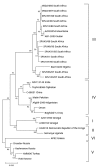Persistence of Crimean-Congo Hemorrhagic Fever Virus RNA
- PMID: 31961316
- PMCID: PMC6986852
- DOI: 10.3201/eid2602.191460
Persistence of Crimean-Congo Hemorrhagic Fever Virus RNA
Abstract
Crimean-Congo hemorrhagic fever virus (CCHFV) causes severe disease with fatalities. Awareness of potential sources of infection is important to reduce risk to healthcare workers and contacts. We detected CCHFV RNA in formalin-fixed, paraffin-embedded tissues from a spontaneous abortion that were submitted for histology 9 weeks after a suspected CCHFV infection in the mother.
Keywords: CCHFV; Crimean-Congo hemorrhagic fever virus; RNA detection; South Africa; orthonairoviruses; viruses.
Figures

References
-
- Burt FJ. Laboratory diagnosis of Crimean–Congo hemorrhagic fever virus infections. Future Virol. 2011;6:831–41. 10.2217/fvl.11.47 - DOI
Publication types
MeSH terms
LinkOut - more resources
Full Text Sources
Medical

